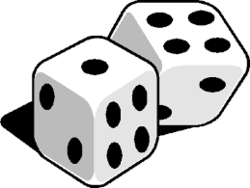DIE AND COINS
 Alice throws a die. If she gets a 5 or a 6, she tosses three coins and notes the number of heads. Out of these three coins, one is a two-headed-coin and the rest of the two are biased coins each showing heads 75% of the time.
Alice throws a die. If she gets a 5 or a 6, she tosses three coins and notes the number of heads. Out of these three coins, one is a two-headed-coin and the rest of the two are biased coins each showing heads 75% of the time.
If she gets 1,2,3, or 4, she tosses two coins, one biased (showing heads 75% of the time) and one fair coin, noting whether a head or a tail is obtained.
After Alice throws the die once, she obtains exactly one head. Then if the probability that she threw 1,2,3 or 4 with the die is where and are coprime positive integers, what is the value of
The answer is 33.
This section requires Javascript.
You are seeing this because something didn't load right. We suggest you, (a) try
refreshing the page, (b) enabling javascript if it is disabled on your browser and,
finally, (c)
loading the
non-javascript version of this page
. We're sorry about the hassle.
This problem asks for the probability of an event given an observation. This makes it an excellent candidate for Bayes' Rule.
Bayes' theorem gives us the following relation:
We evaluate P ( 1 H ) by expanding it using conditional probabilities:
We evaluate each of these expressions separately:
This gives us all of the information we need to calculate the solution.
This means that m = 1 6 and n = 1 7 , so m + n = 3 3 .